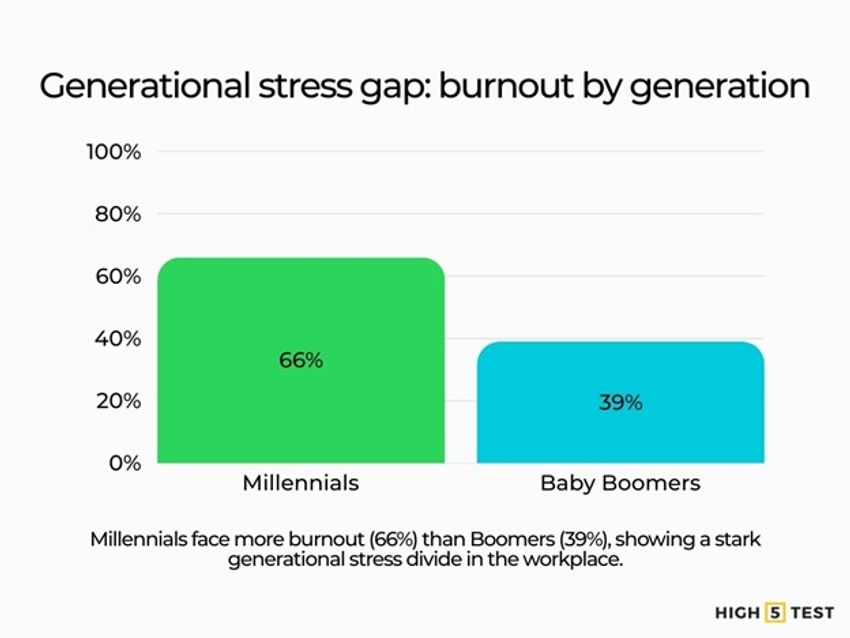Mental health–related work absences have increased, driven by a generational stress divide, challenging employers and managers to expand mental health resources for their staff.
In this article, I will discuss the lab manager’s role in assisting lab staff who may be suffering from specific mental health challenges.

This graph shows a sharp increase between 2015 and 2019 in the number of poor mental health days US employees reported per month.
Credit: esri
Create an emotionally safe work environment
Lab managers can create an environment that supports mental health by leading with openness and authenticity. Admitting mistakes, seeking input from staff, and inviting feedback demonstrate humility and approachability. This kind of vulnerability builds trust and shows employees that it’s safe to be honest about their own challenges. Including mental health as a topic in regular safety meetings can further normalize these discussions and encourage staff to speak up when they need support. Lab managers can also arrange training for their lab teams on topics like:
- Crisis response: equips staff with the knowledge needed to respond to crises at work.
- Suicide prevention: offers staff skills and strategies to help identify and support a co-worker who may be suffering with thoughts of suicide.
- Workplace mental health: provides employees with skills in recognizing and supporting coworkers who are experiencing mental health challenges.
- De-escalation: designed to aid in crisis prevention by teaching staff techniques to peacefully resolve intense situations and conflicts.
These trainings are offered through many online resources and may also be available through your institution's safety training program. Taking these trainings yourself—and encouraging your lab members to do the same—reinforces your commitment to building an emotionally safe work environment.
With a supportive work environment in place, the next step is learning how to navigate some of the most common mental health struggles among staff.
Depression
Scenario: a member of your lab has started taking more sick days than usual. You notice that this person is also much quieter than usual, avoids eating lunch with labmates as they did previously, and has been falling asleep at every lab meeting over the past month. Based on this and other observations, you believe they are struggling with depression. What can you do?
Depression can disrupt sleep patterns, leaving individuals tired, drained of energy, and lacking motivation. This can deplete a person’s ability to identify their own emotions and make decisions. Here are some things lab managers can do in this situation to help:
- Express concern and practice active listening.
This is where creating an emotionally safe work environment will be particularly beneficial. You have already laid the groundwork for an empathetic work environment that actively normalizes mental health discussions. Pull the person aside to a comfortable place where you can have a private conversation. Express your concern to them in a non-judgmental way, then listen. Asking open-ended questions encourages your lab mate to share their feelings. Reflective listening, where you repeat key points, will show your lab mate that you understand what they are saying, and will encourage them to share as much as they are comfortable with. Be sure to respect boundaries and do not force them to share more than they want to.
- Encourage professional help.
Because depression can rob people of the energy that they need to put toward problem-solving, you can offer options for your lab mate to seek professional help. Knowing what mental health treatment options are available through your organization’s health insurance and sharing that information can provide valuable support. If your organization has an employee assistance program (EAP), give your lab mate the proper contact information to get in touch with them. EAPs often offer a limited number of counseling sessions and can also help employees identify resources in the community for mental health care.
- Be open to accommodations.
Offering flexible work can help staff who are struggling with depression by allowing them time to attend therapy and psychiatry appointments during working hours. Flexibility in schedule, when feasible, can also allow your lab mate to work during the times of day when they feel the best, eliminating the stress of getting to work at a specific time and/or leaving at a specific time. Take advantage of this, if possible.
- Work with your colleague to prioritize tasks.
Depression can impact your lab mate's ability to properly manage their workload. Meeting with them regularly to check in and provide guidance on work priorities can help alleviate work-related stress, manage their workload, and let them know they can come to you for support. Consider redistributing some of their responsibilities temporarily if that is helpful to them. Avoid dictating to them what they must do about their mental health and work productivity, and instead work with them to find solutions that will help them through this time, while maintaining accountability for getting their work done.

This chart reflects the workplace stress divide between the Baby Boomer and Millennial generations.
Credit: Aflac
Parental burnout from competing responsibilities
Scenario: A team member has recently seemed distracted and short-tempered, often clashing with colleagues and struggling to stay focused. They share that now that their children have entered elementary school, their family’s routine has changed—mornings are more hectic, evenings are filled with schoolwork and activities, and the constant juggling between home and work responsibilities has become overwhelming. What should you do?
- Listen to understand.
When a team member opens up about personal struggles, it can be easy for a lab manager to feel defensive if the conversation includes frustrations about workload, scheduling, or perceived lack of support. Instead of reacting, focus on understanding their perspective. Acknowledge that while you may not be able to solve every problem, you’re committed to listening and exploring what’s within your control.
Try using sentence starters from stress and resilience expert Paula Davis to keep the dialogue constructive:
- Help me understand…
- Walk me through that…
- Tell me more…
- I’d like to hear your feedback about something I’ve noticed lately…
These prompts promote empathy, reduce tension, and invite collaboration rather than blame.
- Encourage balance through self-care and available resources.
Remind your team member that self-care isn’t indulgent; it’s necessary. Encourage them to prioritize healthy habits like sleep, regular meals, and exercise, and to use institutional resources that support wellness. Many organizations offer wellness seminars or parental support groups—whether internal or community-based. Connecting them with these resources demonstrates care and helps them feel supported both at work and at home. - If your institute’s policy allows, suggest to your lab mate the option of using their sick time to take mental health days to allow them time away from work. This shows compassion for your staff and allows them some time away from work to recover from their burnout without adding any additional stress to other team members.
- Model healthy boundaries.
Your team takes cues from your behavior. Demonstrating a balanced approach to work—leaving on time when possible, taking breaks, and managing your own workload responsibly—signals that well-being is valued, not sacrificed for productivity. When leaders model healthy boundaries, it gives staff permission to do the same without guilt or fear of judgment.
After addressing mental health challenges initially, it’s important to maintain open communication with your staff. You will want to check in regularly to adjust plans and accommodations, as needed, as they move through their challenges.
Creating a work environment that supports and normalizes mental health challenges—whatever their cause—helps retain valuable staff and fosters a culture of trust and loyalty. While others may need to shoulder additional responsibilities when a colleague takes time away to focus on their well-being, that support tends to balance out over time. Investing in your team’s mental health ultimately pays off through reduced absenteeism, stronger morale, and improved overall productivity.











